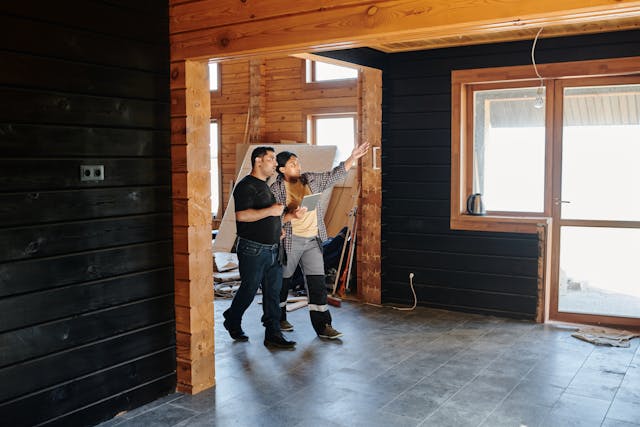Your designs are finalized, all the paperwork is signed, everything is ordered and arriving on time (fingers crossed), and you’ve got a start date with your contractor. Congratulations, you’ve got the first part of your remodeling project done! Home renovations are a major undertaking and can be quite disruptive to you and your family’s regular lives. With some thoughtful planning and preparations, you can minimize the chaos and the stress by prepping your home for the remodel.
Before you do anything, don’t forget to take “Before” photos of the areas to be renovated. These will be a wonderful record of how your home looked before you did any work on it.
1. Clean, Declutter, and Box Up.
Work in the areas that will be renovated, and begin by going through all the items in these spaces. You will need to take everything out, including items inside cabinets and drawers, on shelves, or on the counter. Unused and unneeded things can go right into a “donations” box—anything you won’t want or need after the remodel, get rid of it now. Broken, stained, or expired items should be tossed or recycled.
Next, set aside the things you will use during the remodel, whether it’s clothing, toiletries, small appliances, or electronics. Be a minimalist with this. For instance, set aside just enough place settings for the number of people in your household. Keep out only the small appliances you use daily, such as your coffee machine—less used items such as your stand mixer, blender, or Crockpot can be put away during the renovations. Check your calendar for upcoming events you’ll need certain items for. You don’t want to end up frantically searching for and digging out a cocktail dress and fancy jewelry for a party you forgot about.
Large items or furniture will need to be moved into other rooms, the garage, or a storage facility. What should remain are the things you will be okay not having easy access to during the remodeling. These items should be boxed up and labeled well.
2. Decide What You’re Storing and Where.
For the items you’ll be using during the renovations, consider your storage options. Got a spare room or closet that is not part of the remodel? That is a great place to keep these things, especially if will be “living out” of these spaces for now. Consider using small, handled bins for toiletries, as well as rolling storage carts that are lightweight and easy to move around.
As for the things you won’t be using during the remodeling period, figure out if you will be able to store it all at home, or if you’ll need to rent either a portable storage container for your driveway, or a storage unit offsite. If your garage will not be remodeled, that’s another great space for boxes or large bins you don’t need daily access to.
3. Set Up Your Living Areas.
While some areas of your home are being renovated, you’ll have to set up other areas where you can generally live and work. Set it up as privately as you can (use folding screens or temporary curtains if need be), and as out of the way of the construction and the workers’ paths. Then put together your supplies (clothing and toiletries, coffee maker, cooking/eating items, folding chairs/table, etc.) for eating, drinking, and generally living in the home. You can also use these spaces to secure anything you’re particularly worried about protecting, such as valuables, electronics, or decorative items.
4. Keep Kids and Pets Safe.
Construction areas are a major danger zone for small kids and pets, who are usually the most curious and quick-moving beings in your home! Loose debris, sharp tools and objects, exposed electrical work, maybe even hazardous materials—no bueno! Use child safety gates to keep them out of the work areas, and make sure the workers know to keep these closed at all times.
5. Update or Reconfigure Your Security System.
There will be lot of people you don’t know going in and out of your home during a remodel, and sometimes you won’t be home. Keep your documents safe in a locking file cabinet or closet. Make sure your electronics have passwords. Lock or seal off any areas of your home that you don’t want workers entering.
To control entry into your home, install a lockbox if you’re concerned about making copies of keys and keeping tabs on who has them. Better yet, upgrade to a programmable lock for your front door that allows you to give your contractors access to your home during the work; and reprogram the lock when the work is done. Smart locks controlled via a smartphone app are another great upgrade, as they enable you to conveniently control who can access your home and when.
6. Use Up Your Stuff.
To lessen what you have to pack and move elsewhere, use up what you can, especially in the kitchen. Eat up what’s in your freezer and refrigerator first, then move on to the pantry. It’s also a good time to toss out expired food items.
7. Give Neighbors a Heads-Up.
It would be courteous to let them know about the big dumpster in your driveway and the noise that will be a part of their lives for some time. Let them know in advance what work will happening and when, so they don’t plan their niece’s garden baby shower while the noise and dust from your kitchen and dining room expansion is happening.
Doing any kind of renovation on your home, whether it’s one room or the entire house, is a huge undertaking that will require patience and a bit of Zen. Expect the unexpected, take a lot of deep breaths, and have a very open communication channel with everyone involved. When it’s finally over and you are using these beautiful new spaces, your home will feel yours again and you will enjoy the work that was done!

